Russianhood as a factor for the formation of civil identity in modern Kazakhstan
July 17th – August 13th, 2015
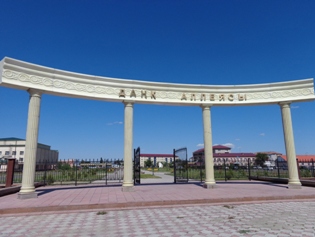 |
| The central square in the city of Usharal |
Main research method used – participant observation. Complementary methods used: semi-structured interviews, observation, analysis of mass media reports and public speeches by representatives of the authorities, and taking photographic images.
The first objective of the carried-out field research was to consider ‘Russianhood’ as a factor for the formation and representation of civil identity in modern Kazakhstan.
The city of Usharal of the Alakol district in the Almaty region was chosen as a case study and my strategy was to observe, to the greatest extent possible, what problems the locals are most preoccupied with, how Russians feel about living here and in general, if there are any ‘Russianhood’–related issues here.
The choice was largely defined by the accessibility of the field to me (which was very important given the time limits for the fieldwork). Plus, my maternal relatives still live in the area. They are Russian and so it seemed reasonable to me to get into that via communicating with them and immersing myself in their everyday life, including work, leisure and also day-to-day problems.
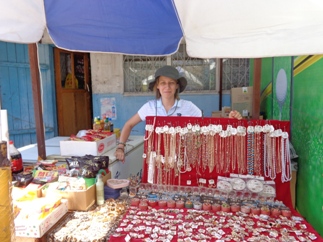 |
| The market in the city of Usharal |
The entering point to the city ‘community’ (the quotes here indicate the relative character of the term used) was the local market where I got in contact with the sellers. Together with my aunt I was selling Chinese bijouterie (the so-called ‘medical gold’). Every day (sometimes taking breaks for interviewing or working at the library), at 09:00 p.m., we would go together to the same spot of ours, lay out the bijouterie and wait for buyers till 16:30 (the market closes at 17:00). Next to us were some ladies selling soft drinks and given that the average temperature was around +35+40 degrees Celsius at the time, a lot of people would come here to buy some. As such, the market is a good place for research, as there are always many people coming and going while constantly talking with one another.
The limitation was, however, that it was impossible to observe all the market, but just a part of it (although sometimes taking on the role of a buyer I would get to talk to other sellers as well). Another difficulty was the language barrier: although most of the time the Russians and the Kazakhs would communicate in Russian, when it came to the Kazakh language, I had a difficult time interacting.
Among my informants there were a few Russian families from the city of Usharal as well as the villages of Zhalanashkol and Takhty.
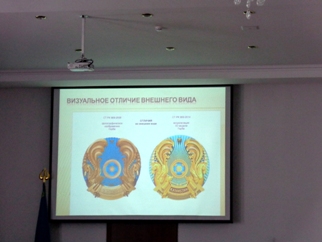 |
| The changes in the coat of arms of Kazakhstan |
Apart from working in the market (observing things and following daily conversations which would be written down in my field notes on a daily basis), I would also go to the city and region akimat (administration offices) and the district library. I also indirectly got to know a local journalist who gave me a CD with some articles but did not agree to give an interview saying he was too busy.
One of the most vivid observations was made in the district akimat, during two seminars organized for the heads of akimats, schools, libraries and houses of culture. One of the seminars was dedicated to the new state symbols (to be precise, to the ‘new’ state symbols, as the changes made to the coat of arms were insignificant), the other dealt with something that in the Soviet time would be called ‘ideological education’ – the speakers were speaking from the podium about how important it is for the prosperity of Kazakhstan to follow the presidential programme ‘100 steps’. Out of around 70 people being present in the hall, there was only ONE Russian girl (and it turned out that she was a photographer) and that allows for a certain conclusion concerning the extent to which Russians are represented in the governing positions in modern Kazakhstan.
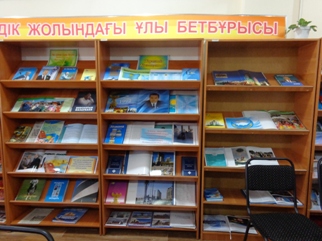 |
| A stand in the Usharal city library |
The situation concerning the availability of books in Russian in the district library, although pretty similar to the developments unfolding in the governing positions, was somewhat ambiguous. The books one could see on the shelves in the reading hall here are mainly in Kazakh. According to one of the oldest librarians, books in Russian arrive once in a quarter, but mostly it is books in Kazakh that are provided. Some shelving units were designed as thematic exhibitions (see the picture, from left to right): the 550th anniversary of the Kazakh statehood (1465 – 1847), along with materials dedicated to the great batyrs; the 70th anniversary of the Victory in the Great Patriotic War (to the role of the Kazakh people in it); THREE shelving units presenting works by N.A. Nazarbaev and on the side wall – two shelving units dedicated to regional and national poets and writers. What is it if not a representation of hierarchies (and components) of national identity..?!
However, one should not jump to conclusions as to the presence of the Russian language as (and it was clearly stated in an interview of the founder of the Slavic ethno-cultural centre of the city of Usharal – this public organization is called differently today and its objective is to tackle mainly social issues, thus it goes beyond the sphere of culture) the Internet has become a powerful competitor of libraries – people are all the more reading online.
To sum up this brief overview of some of the most vivid moments experienced in the field, it is worth noting that I managed to collect quite a lot of materials on the topic and they require further analysis and comprehension. The field produced more questions than answers and in my view this is the main result of my fieldtrip.
As was said earlier, the case of Usharal was not the only goal of my trip to Kazakhstan. The second goal was to collect additional material in the village of Shygys which was the first field of my research in Kazakhstan in summer 2013. The then gathered material was used for a few publications which covered the issue of repatriates in the context of the ‘cultural citizenship’ concept. This time, it was necessary to explore in more detail the situation with village houses, namely whether they underwent reconstruction, or how the locals cope with their debts and what has changed in general since my last time here (on the conflict in Shygys, please see more in Irina G. Popravko. ‘True Kazakhs’ in the space of language, culture and time (the Oralman and the ‘cultural citizenship’ // Diasporas (independent scientific journal), 2014, issue 2. pp. 39 – 56.) The emphasis on the material side of the problem is accounted for by my interest in the actor-network theory (ATN) as a theory that gives a new language of description and comprehension of the ongoing events. According to the ANT:houses built in violation of all the norms and requirements,
- officials and contractors who stole the money that was to ensure the proper quality of the houses,
- people who were cold in those houses and started to warm up using electric heaters,
- energy sector workers who established certain electricity tariffs,
- residents of the neighbouring village who took the ‘revolt’ of the Oralman quite painfully due to the exceedingly high electricity bills,
- representatives of the city akimat who got to talk to the outraged residents of Shygys,
- bank representatives with whom the city akimat representatives negotiated the debt restructuring…
… all these constitute a NETWORK where each actor (actant) influences the situation. And the collectivity (R. Brubaker) formed in the course of this conflict – or group identity of the Oralman of Shygys – also is one of the network actants.
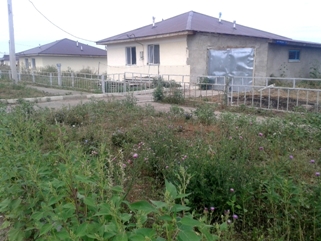 |
| A repaired house in the village of Shygys |
What is the result? A few houses have been insulated, largely at the expense of the residents or of sponsors that they themselves found. Here is an illustration of the situation according to foreman Andrey Zaguzov from ‘Oksemen-Vodokanal’ organization which was repairing at the time (at sponsors’ expense) a house of an old woman from the village of Shygys, Nurkamal Aubakir: ‘We are changing everything: entrance room, tile, bathroom fitment. The base plate has sunk as it was placed without taking into account waste- and meltwater and moreover it turned out to be just 5 cm thick! It is unbelievable! The walls are made of thin foam blocks. In fact, these houses are just a skeleton construction which is yet to be completed to have real and not foam block walls, ceiling, strengthened base plate and so on’ (Fominykh E. An excuse which is worth a million // Kazakhstan social and political newspaper ‘Vremya’. November 23, 2013).
They have allowed install stoves for heating houses (see the pic.). It is unclear though, when the people will be able to officially obtain ownership of their homes. Some of them purposefully do not arrange the curtilage (it can even be seen in the pic.) or make any quality repairs of their homes, seeing their stay therein as temporary, while others, on the contrary, actively set up gardens and construct outbuildings. Some who are more adventurous set up small businesses – they saw boards, produce cement blocks and sell them to their neighbours. This is how a particular network and a special world of the Oralman are created away from the city (in the city, due to the lack of knowledge of Russian they can hardly find any job). And one of my near-future tasks is to describe this network including its material actants.
Irina G. Popravko
LSAR Leading Research Fellow





 The project "Man in a Changing World. Identity and Social Adaptation: Past and Present" is funded by the Russian Government
The project "Man in a Changing World. Identity and Social Adaptation: Past and Present" is funded by the Russian Government 